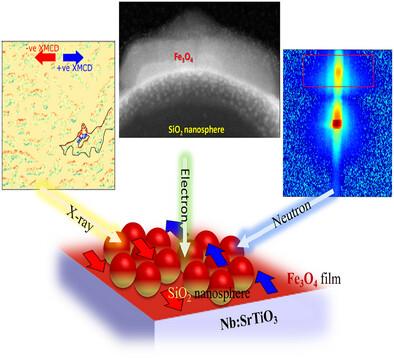Magnetic Domain Texture in Fe3O4 Thin Films on SiO2 Nanospheres
IF 26.8
1区 材料科学
Q1 CHEMISTRY, MULTIDISCIPLINARY
引用次数: 0
Abstract
Topographically complex interfaces offer a promising route to engineer magnetic textures in oxide thin films, with potential implications for next-generation spintronic and neuromorphic devices. Here, Fe3O4 thin films are grown on self-assembled SiO2 nanospheres to investigate how local curvature, together with polycrystalline morphology, influence magnetic behavior compared to flat films. STEM and GISANS confirm connected growth with preserved lateral ordering, while XMCD-PEEM reveals in-plane magnetic domains that extend across both nanosphere-patterned and flat regions. Despite the low net magnetization of the Fe3O4 caps, their domain orientations align with neighboring flat areas, indicating correlated domain behavior across structurally different regions. These findings demonstrate how nanoscale topography and morphology can be leveraged as design parameters to modulate magnetism in complex oxides.

二氧化硅纳米球表面Fe3O4薄膜的磁畴织构
地形复杂的界面为设计氧化薄膜中的磁性结构提供了一条有前途的途径,对下一代自旋电子和神经形态器件具有潜在的影响。本研究将Fe3O4薄膜生长在自组装的SiO2纳米球上,以研究与平面薄膜相比,局部曲率和多晶形貌如何影响磁性行为。STEM和GISANS证实了与保持横向有序的连接生长,而XMCD-PEEM则揭示了在纳米球形和平面区域扩展的平面内磁畴。尽管Fe3O4帽的净磁化强度较低,但它们的畴取向与邻近的平坦区域对齐,表明不同结构区域的畴行为相关。这些发现证明了纳米尺度的形貌和形态可以作为设计参数来调节复杂氧化物中的磁性。
本文章由计算机程序翻译,如有差异,请以英文原文为准。
求助全文
约1分钟内获得全文
求助全文
来源期刊

Advanced Materials
工程技术-材料科学:综合
CiteScore
43.00
自引率
4.10%
发文量
2182
审稿时长
2 months
期刊介绍:
Advanced Materials, one of the world's most prestigious journals and the foundation of the Advanced portfolio, is the home of choice for best-in-class materials science for more than 30 years. Following this fast-growing and interdisciplinary field, we are considering and publishing the most important discoveries on any and all materials from materials scientists, chemists, physicists, engineers as well as health and life scientists and bringing you the latest results and trends in modern materials-related research every week.
 求助内容:
求助内容: 应助结果提醒方式:
应助结果提醒方式:


